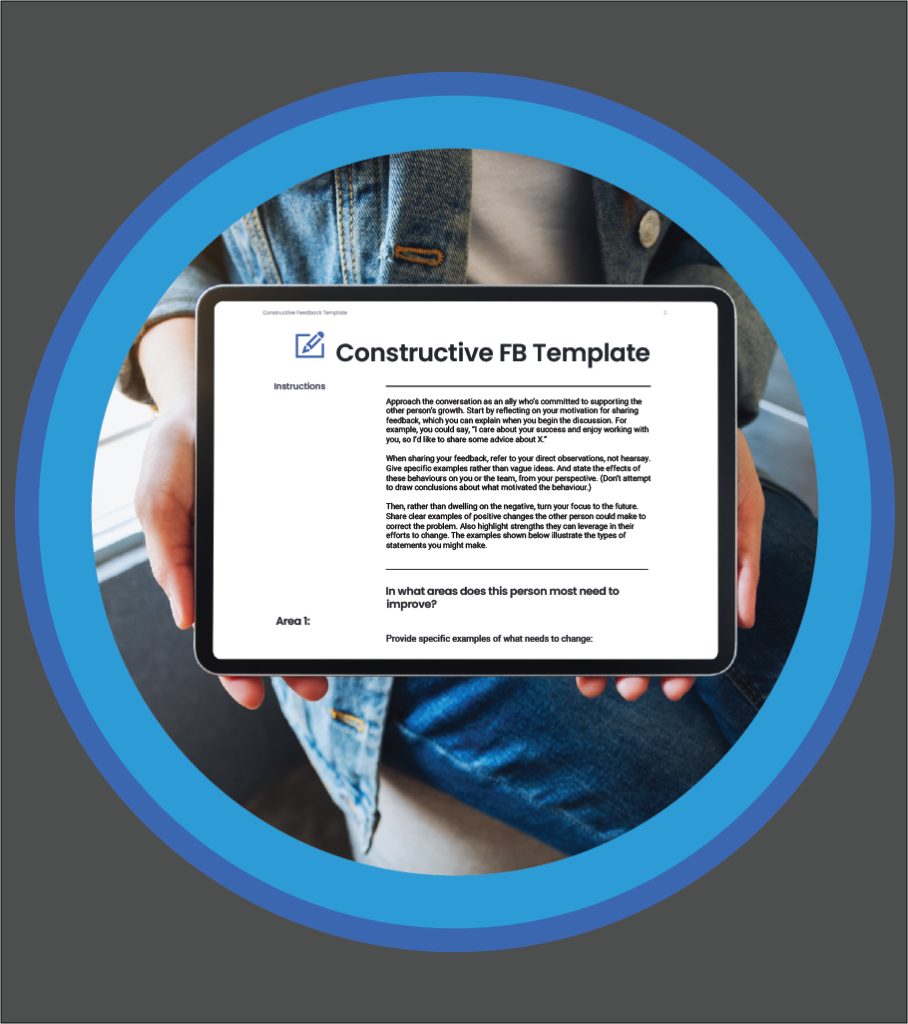Feedback plays a crucial role in enhancing employees’ effectiveness. Whether it takes the form of peer feedback or feedback from managers, it strengthens each team member’s abilities. That’s one of the reasons we’ve compiled this of constructive feedback examples.
In performance management, we recognize two types of useful feedback:
- Positive feedback, which shares appreciation or points out what is going well.
- Constructive feedback, which points out issues to correct or areas to strengthen.
Constructive feedback focuses on how to improve performance. We never refer to constructive feedback as “negative feedback”—because it’s not! We would only view feedback as “negative” if it were stated in a harsh way. Constructive feedback must be given in a supportive tone, with the intent of helping the other person improve.
Why is constructive feedback so useful?
- Coworkers often have important insights on one another’s performance. They frequently spot opportunities for peers to improve. This peer feedback can strengthen relationships and performance. Feedback on communication can help people learn to better relate to team members, for example.
- Using performance management software and personal observations, managers gain a range of constructive input for their direct reports. They must communicate these insights so employees will benefit from them.
- In turn, managers and leaders can receive valuable input from employees through constructive feedback. They must actively seek it out to encourage employees to share it.
Let’s look at how to deliver constructive feedback for best results. Then, we’ll share some good constructive feedback examples.
Table of Contents
1. How to Provide Constructive Feedback
2. Constructive Feedback Examples
3. Template to Use with Constructive Feedback Examples

How to Provide Constructive Feedback

Following best practices for sharing constructive feedback will help others to better hear it.
Frame It as Advice.
Advice focuses on what they can do now, or later on, not on what they did wrong in the past. So, strive to give advice rather than criticism.
A recent study found that when asked to give advice, participants gave far more actionable suggestions than when asked to give feedback. “Compared to those asked to give feedback, those asked to provide “advice” suggested 34% more areas of improvement and 56% more ways to improve,” write the researchers.
Be Compassionate.
First, be empathetic in your delivery. Speak in a supportive tone. Presume the other person had the best of intentions, even if they made a mistake. This approach will help them feel supported rather than threatened.
Second, respond with compassion if the other person reacts emotionally. You can’t control how they feel, but you can manage your own emotional response, as Kim Scott says on Radical Candor.
Provide Positive Reinforcement.
Acknowledge ways in which the employee has improved. This will inspire a can-do attitude. Also look for ways to leverage their strengths in making necessary changes.
Explain Potential Consequences.
Convey the consequences of not making necessary changes. Illustrate the impacts on others so they’ll take the feedback to heart.
Teach People to Ask for Feedback.
Coach people on how to ask for feedback. When they ask for feedback, they’ll be far more receptive to it. Plus, others will be far more likely to share input when asked.
Share In-the-Moment Feedback.
Whenever possible, share feedback in real time. Using employee feedback tools, you can quickly share observations with employees. This can complement your one-on-ones, making feedback an ongoing conversation throughout the week.
Now, let’s look at some great examples of constructive feedback to use in your daily work.
Constructive Feedback Examples

These constructive feedback examples illustrate how to tactfully address different areas of performance management. They relate to topics like the following:
- Goal-achievement
- Punctuality
- Stress-management
- Engagement
- Ambition
- Skill development
These are just a sampling of the areas addressed here. Importantly, after sharing one of these observations, give actionable advice on how the other person can change their behaviour.

Download Now: Free Constructive Feedback Template [Get Your Copy]
Reliability
- “Is often late to meetings—it would be great to have their full participation.”
- “Is frequently absent from work.”
- “Often works overtime and seems overwhelmed.”
- “Falls behind on goals and objectives, holding back team progress.”
- “Often procrastinates on tasks and projects, scrambling to finish them at the last minute.”
- “Shows up unprepared for meetings or presentations.”
- “Frequently seems stressed out, acting irritated or angry.”
- “Makes lots of mistakes, lacking attention to the finer details.”
- “Produces work that misses the mark, not meeting quality expectations.”
- “Doesn’t usually take initiative to solve problems. Stepping up to do this more often would help the team.”
- “Lets progress get blocked by obstacles that arise, rather than working to overcome them.”
For managers:
- “Struggles with handling complex situations, getting overwhelmed or checking out.”
Communication
- “Needs to express thoughts more clearly.”
- “Should share more input with the group in discussions.”
- “Needs to become more tactful—often shares feedback too bluntly.”
- “Often interrupts others—needs to genuinely listen to them.”
- “Doesn’t seem open to feedback, resisting input when others share it.”
- “Gets defensive when others make suggestions or requests for improvement.”
- “Needs to practice explaining new concepts to others.”
- “Seems distracted when others are speaking, rather than listening actively.”
- “Needs to work on persuasive abilities. When making pitches to clients, their ideas tend to fall flat.”
- “Does a lot of talking and not a lot of listening.”
- “Must show more tact when handling customer concerns.”
- “Needs to ask questions when unsure about something.”
- “Must communicate potential project delays, asking for an extension in advance when needed.”
For managers:
- “Needs to more clearly communicate team goals, priorities, and steps toward them. People
are often left guessing about these things.”
Integrity
- “Needs to take more accountability for mistakes, working to resolve them.”
- “Often fails to follow through on promises.”
- “Lacks compassion for others when they’re going through stressful times.”
- “Frequently gossips about other employees, decreasing trust.”
- “Assumes all the credit for group projects, when multiple people actually contributed.”
- “Needs to share praise for others more often.”
- “Doesn’t help others when asked; needs to be more of a team player.”
- “Doesn’t embody organizational values.”
- “Frequently displaces blame for problems onto others.”
- “Must develop a strong moral compass to guide behaviour.”
For managers:
- “Needs to be more transparent about things the team needs to understand.”
- “Displays bias toward certain employees.”
- “Makes rash decisions rather than carefully thinking through the options (and how they’ll
affect the organization).”
- “Needs to build trust with individuals by supporting their growth.”
- “Needs to recognize and reward employees’ hard work on a regular basis.”
Collaboration
- “Quickly shuts down new ideas rather than being open to exploring them.”
- “Rarely expresses creative or insightful ideas, despite intelligence and experience.”
- “Needs to share expertise more often in collaborations.”
- “Works well independently but doesn’t actively participate in group collaboration.”
- “Needs to be more transparent about project status and updates—we’re always left guessing.”
- “Only wants to work on ideas they’ve come up with, rather than others’ ideas.”
- “Doesn’t work well with others who follow a different approach to group work.”
- “Seems to be guided by emotions rather than logically weighing the options.”
- “Needs to develop analytical abilities and use them in group decision-making.”
For managers:
- “Needs to learn to facilitate a meeting well, to make things more productive and focused.”
- “Needs to encourage all employees to contribute in meetings; makes no attempt to
draw out quieter voices.”
- “Needs to ensure that next steps are laid out by the end of a meeting, along with who is
responsible for carrying them out.”
Relationship-Building
- “Doesn’t show a genuine desire to get to know coworkers.”
- “Has weak relationships with clients, not getting to know them as individuals.”
- “Only builds a rapport with a select few people with whom they work closely, ignoring the rest.”
- “Stays in their own silo, not building cross-functional relationships.”
- “Fails to address conflict, letting it continue to simmer under the surface.”
- “Gets into frequent conflicts that rarely end well, harming relationships.”
- “Often doesn’t seem to notice how others are feeling. Would benefit from tuning into others’ emotions more.”
- “Lacks self-awareness, not realizing how their behaviour affects others.”
- “Makes inappropriate jokes that make others feel uncomfortable.”
For managers:
- “Practices favouritism, giving some direct reports more support than others.”
- “Doesn’t address problematic behaviour in employees, letting it continue.”
Attitude
- “Engagement has been slipping over the past several months.”
- “Confidence is lacking, even though they’re smart and capable.”
- “Needs to show a more positive attitude in meetings.”
- “Never asks others for help, though others would be glad to pitch in at times.”
- “Doesn’t seem to have a strong work ethic, truly grasping the importance of the work.”
- “Seems to lack understanding of the team’s vision and mission.”
For managers:
- “Needs to take a more hands-on approach, providing more coaching to employees.”
- “Must instill a sense of psychological safety, creating an environment where employees
feel free to express ideas.”
- “Punishes people for trying and failing, even when they’ve made a strong effort.”
- “Needs to stop micromanaging people, letting them carry out their work in their own way.”
Time-Management
- “Send emails late at night or on weekends.”
- “Rushes from one thing to the next all day long, always seeming harried.”
- “Needs to develop the discipline to stick to a schedule.”
- “Lacks boundaries, frequently interrupting others’ work.”
- “Doesn’t convey a sense of urgency for finishing important projects.”
- “Lets their own work get interrupted by anything that comes up in the moment.”
- “Is too perfectionist, not seeming to know when to consider a task ‘finished.’”
- “Maintains a manageable workload, saying no when necessary.”
- “Struggles to accurately estimate the time a task will take. Consistently underestimates and runs short on time.”
- “Doesn’t work well under pressure; needs to handle urgent tasks more skillfully.”
For managers:
- “Needs to help direct reports learn to prioritize.”
- “Must carve out time for regular one-on-ones and quick check-ins.”
- “Should learn to delegate tasks effectively instead of trying to do it all.”
- “Helps each direct report maintain a realistic workload.”
Achievement
- “Goals could be more ambitious—I don’t think this person aims high enough.”
- “Focuses on the wrong priorities, getting easily sidetracked from goals.”
- “Is behind on achieving KPIs laid out for this quarter.”
- “Lacks clarity on expectations and role.”
- “Experiences role creep, taking on responsibilities that don’t fit into it.”
- “Needs to strengthen technical abilities in certain areas that are becoming central to our work.”
- “Would benefit from developing more advanced skills through trainings.”
- “Progress toward personal goals seems slow—gets too caught up in less important priorities.”
- “Needs to balance productivity and quality of work.”
For managers:
- “Needs to get comfortable directing the team and guiding people toward a common goal.”
- “Needs to help the team (and employees) establish strong goals and KPIs.”
- “Must help individuals set a clear path toward personal goals.”
As mentioned, share actionable advice after making a constructive observation. For example, you could share this advice for a stressed-out employee: “I would love to see this employee go home on time on most days. I think their stress level might really decrease as a result.”
Finally, here is a template for giving constructive feedback. Managers can use it to prepare for routine one-on-ones, but peers may also find it helpful!
Template to Use with Constructive Feedback Examples
Manager:
Employee:
Date:
In what areas does this employee most need to improve?
Area 1: ________________________________________________
Provide specific examples of what needs to change:
__________________________________________________________
__________________________________________________________
__________________________________________________________
Why does it need to change (what are the consequences of the behaviour)?
__________________________________________________________
__________________________________________________________
What should the employee do differently? (State expected behaviour.)
__________________________________________________________
__________________________________________________________
__________________________________________________________
What support can you provide to assist in making these changes?
__________________________________________________________
__________________________________________________________
__________________________________________________________
Area 2: ________________________________________________
Provide specific examples of what needs to change:
__________________________________________________________
__________________________________________________________
__________________________________________________________
Why does it need to change (what are the consequences of the behaviour)?
__________________________________________________________
__________________________________________________________
What should the employee do differently? (State expected behaviour.)
__________________________________________________________
__________________________________________________________
__________________________________________________________
What support can you provide to assist in making these changes?
__________________________________________________________
__________________________________________________________
__________________________________________________________
Area 3: ________________________________________________
Provide specific examples of what needs to change:
__________________________________________________________
__________________________________________________________
__________________________________________________________
Why does it need to change (what are the consequences of the behaviour)?
__________________________________________________________
__________________________________________________________
What should the employee do differently? (State expected behaviour.)
__________________________________________________________
__________________________________________________________
__________________________________________________________
What support can you provide to assist in making these changes?
__________________________________________________________
__________________________________________________________
__________________________________________________________
In what areas does the employee excel most?
__________________________________________________________
__________________________________________________________
__________________________________________________________
Provide specific examples of strong performance in these areas:
__________________________________________________________
__________________________________________________________
__________________________________________________________

With the aid of these constructive feedback examples and the above template, managers will improve the quality of their feedback. Peers will also share higher-quality feedback with one another. As their delivery improves, so will performance. Employees will better understand what they need to change, leading them to achieve at a higher level.
Want to learn more about using performance management software in conjunction with these constructive feedback examples? Demo our product!
